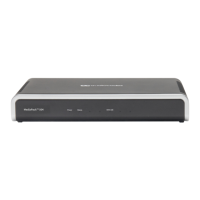Version 6.2 107 February 2011
SIP User's Manual 3. Web-Based Management
Table 3-17: Proxy Sets Table Parameters
Parameter Description
Web: Proxy Set ID
EMS: Index
[ProxySet_Index]
The Proxy Set identification number.
The valid range is 0 to 9. The Proxy Set ID 0 is used as the default
Proxy Set.
Note: Although not recommended, you can use both default Proxy
Set (ID 0) and IP Groups for call routing. For example, on the 'Hunt
Group Settings' page (see ''Configuring Hunt Group Settings'' on
page 126) yo
u can configure a Serving IP Group to where you want
to route specific Hunt Group's endpoints, while all other device
endpoints use the default Proxy Set. At the same, you can also use
IP Groups in the 'Tel to IP Routing' (see ''Configuring the Tel to IP
Routing'' on page 138) to configure the d
efault Proxy Set if the
parameter PreferRouteTable is set to 1.
To summarize, if the default Proxy Set is used, the INVITE
message is sent according to the following preferences:
To the Hunt Group's Serving IP Group ID, as defined in the
'Hunt Group Settings' table.
According to the 'Tel to IP Routing' if the parameter
PreferRouteTable is set to 1.
To the default Proxy.
Typically, when IP Groups are used, there is no need to use the
default Proxy, and all routing and registration rules can be
configured using IP Groups and the Account tables (see
''Configuring Account Table'' on page 113).
Proxy Address
[ProxyIp_IpAddress]
The IP address (and optionally port number) of the Proxy server.
Up to five IP addresses can be configured per Proxy Set. Enter the
IP address as an FQDN or in dotted-decimal notation (e.g.,
201.10.8.1). You can also specify the selected port in the format:
<IP address>:<port>.
If you enable Proxy Redundancy (by setting the parameter
EnableProxyKeepAlive to 1 or 2), the device can operate with
multiple Proxy servers. If there is no response from the first
(primary) Proxy defined in the list, the device attempts to
communicate with the other (redundant) Proxies in the list. When a
redundant Proxy is located, the device either continues operating
with it until the next failure occurs or reverts to the primary Proxy
(refer to the parameter ProxyRedundancyMode). If none of the
Proxy servers respond, the device goes over the list again.
The device also provides real-time switching (Hot-Swap mode)
between the primary and redundant proxies (refer to the parameter
IsProxyHotSwap). If the first Proxy doesn't respond to the INVITE
message, the same INVITE message is immediately sent to the
next Proxy in the list. The same logic applies to REGISTER
messages (if RegistrarIP is not defined).
Notes:
If EnableProxyKeepAlive is set to 1 or 2, the device monitors the
connection with the Proxies by using keep-alive messages
(OPTIONS or REGISTER).
To use Proxy Redundancy, you must specify one or more
redundant Proxies.
When a port number is specified (e.g., domain.com:5080), DNS
NAPTR/SRV queries aren't performed, even if

